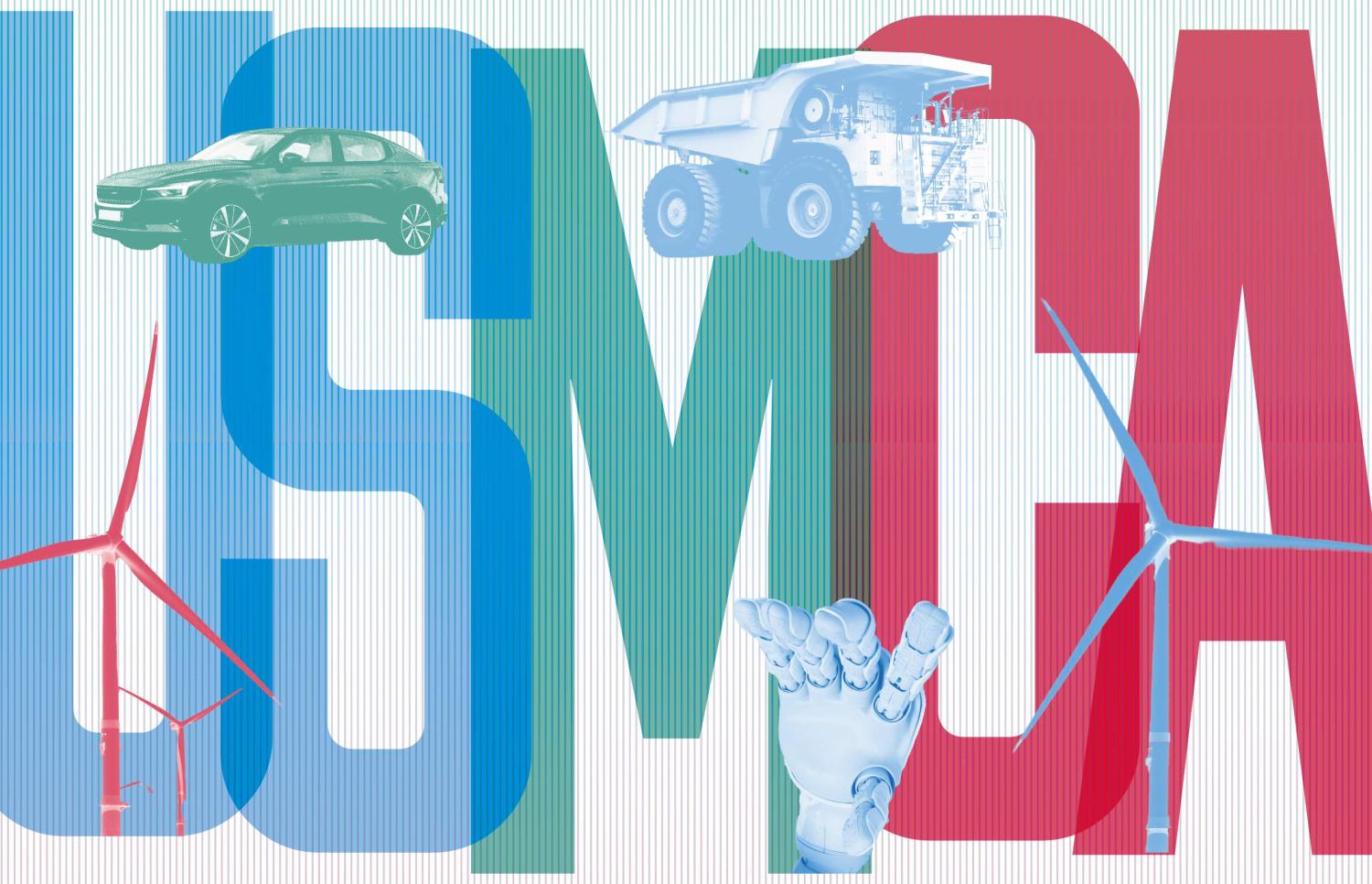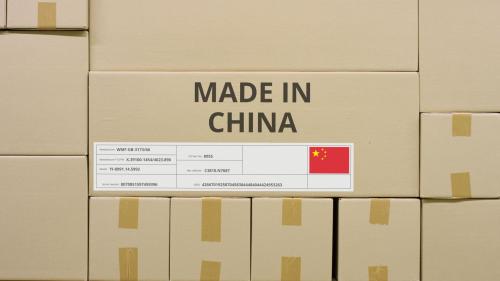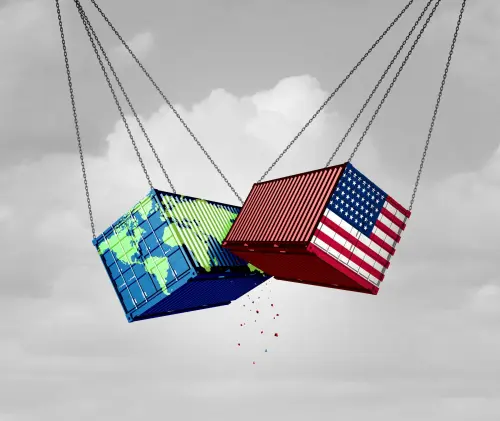This chapter is part of USMCA Forward 2025, which focuses on areas where deepening cooperation between the United States, Mexico, and Canada can help advance key economic and national security goals.
Not long ago the key question on the minds of North American trade watchers was whether the United States-Mexico-Canada Agreement (USMCA) would be extended when it comes up for renewal at its six-year anniversary in July of 2026. In the aftermath of President Donald Trump’s historic return to the White House, and his recent decision to impose 25% tariffs on most imports from Canada and Mexico, the question now is whether the agreement will survive 2025.
In the aftermath of President Trump’s historic return to the White House and his recent decision to impose 25% tariffs on most imports from Canada and Mexico, the question now is whether the agreement will survive 2025.
In one of his first acts after being elected to a second, nonconsecutive term in the Oval Office, President Trump posted a message to his Truth Social platform threatening Canada and Mexico with 25% across-the-board tariffs unless they take steps to stop the flow of people and fentanyl across the Southern and Northern Borders. A hasty pilgrimage to Mar-a-Lago by Prime Minister Justin Trudeau and a major fentanyl bust by Mexican authorities seemed to ease tensions. Yet hours after his second inaugural ceremony concluded, President Trump renewed the threat. And on February 1, he invoked his authority under the International Emergency Economic Powers Act (IEEPA) to impose sweeping, double digit tariffs on the United States’ top two trading partners. Canada and Mexico quickly announced stiff retaliatory measures. As of this writing, a temporary truce appears to have been reached, at least delaying a North American trade war more intense than any on the continent since the 1930s.1
Until recently, the Canadian and Mexican governments expected to defer serious trade talks with the United States until 2026 when the USMCA renewal process is set to begin. They (and many in the U.S. business community) hoped the renewal talks would be more akin to a genteel college reunion than a high-stakes brawl of the kind they experienced during the original USMCA negotiations. That uncertain and exhausting experience was a major drag on the economies of Canada and Mexico, and the reason both countries insisted there be at least six years between the agreement’s entry into force and the first renewal deadline. Their negotiators surmised that, regardless of what happened in the 2020 election, the concessions made in USMCA would buy peace for the duration of the Trump era. It was a reasonable judgment at the time—but one that failed to account for the wildly improbable arc of Donald Trump’s political fortunes.
Even before the February 1 announcement, there were indications the renewal talks would be more, not less, difficult this time around. Unlike in the first round of USMCA negotiations, the agenda likely will go beyond traditional trade disciplines to include migration, drug interdiction, and possibly in the case of Canada, defense spending. That is in addition to the usual recipe of vexing trade irritants like tomatoes and milk and new grievances arising from USMCA itself like the parties’ interpretation of the auto rules of origin and Mexico’s implementation of its 2019 labor reform law.
And this assumes the renewal negotiations will take place at all. If the parties fail to reach a long-term agreement to remove the IEEPA tariffs, whether to extend USMCA may be the least of their concerns. After a few cycles of tit-for-tat retaliation and counter retaliation, President Trump might up the ante by attempting to withdraw the United States from USMCA all together, as he threatened to withdraw from the North American Trade Agreement (NAFTA) in his first term. Such a move would be met with legal challenges in the United States. But even if USMCA does not officially die, at some point, tariff barriers will shift trade patterns and render the agreement dead letter.
The situation is precarious to say the least. Whether it is hopeless depends on whether the parties can defuse the instant tariff imbroglio and turn their focus to the long term. The best way to preserve USMCA is for the parties to double down on the project of North American economic integration and competitiveness. That means Mexico City and Ottawa must disavow any interest in allowing countries outside North America to free ride off the agreement by transshipping goods to the U.S. market through Mexico and Canada. It also means they must more closely align their own tariff, investment, and industrial policies with Washington’s. But a successful conclusion to the negotiations also will require the Trump administration in the end to take “yes” for an answer and offer something other than a temporary respite from future tariff threats. Mexico and Canada’s price for agreeing to the Trump administration’s demands will be the promise of an enduring peace.
Sunset and other scenarios
The purpose of USMCA’s renewal and extension, or “sunset” provision, was twofold: To create an opportunity for the parties periodically to reassess and update the agreement and to give each party (but, in all candor, mostly the United States) leverage to force changes to the agreement without threatening immediate withdrawal. Every six years, each party must provide notice that it wishes to extend the agreement by an additional 16 years. Thus, if the three parties each agree to an extension by July 1, 2026 (the first six-year anniversary of the agreement’s entry into force), the agreement will be extended until 2042. If they fail to agree, a clock will start to tick toward USMCA’s eventual termination in ten years at the end of the original 16-year term (i.e., 2036). The ten-year wind-down period was thought to be short enough to force action in the near to medium term, but long enough to avoid premature disruption and negative market reactions (at least in the initial period following the failure to renew).
But there is nothing to prevent President Trump from forcing negotiations with Mexico and Canada well in advance of the 2026 deadline as news reports suggest. He can do so in two ways—unilateral trade actions and threats of immediate U.S. withdrawal from USMCA.
The Trump administration just pulled the first lever by imposing the IEEPA tariffs. The Executive Order the White House issued on February 1 provides not only for 25% tariffs but also for additional measures to counter retaliatory actions by Canada and Mexico.2 The administration has argued the IEEPA tariffs are allowed under Article 32.2 of USMCA, which provides that nothing in the agreement shall “preclude a Party from applying measures it considers necessary … for the protection of its own national security interests.” This exception was intentionally broadened under USMCA to encompass all “essential security interests,” a significant expansion of the corresponding exception under NAFTA, which defined “essential security” with reference to “traffic in arms,” activities “taken in time of war or other emergency in international relations,” or “non-proliferation of nuclear weapons.” That the parties removed the illustrative examples in USMCA suggests an intent to broaden what constitutes an “essential security” interest.
Mexico and Canada likely disagree with President Trump’s invocation of the exception, but they have no effective remedy to reverse the action. The United States has long maintained that a party’s invocation of the “essential security” exception—a feature of all U.S. trade agreements—is self-judging. Even if Mexico and Canada attempted to put the matter before the USMCA dispute settlement panel and prevailed, it is unlikely the Trump administration would comply with the ruling—just as the Biden administration refused to comply with a World Trade Organization (WTO) dispute settlement panel’s decision that extant Section 232 tariffs on steel and aluminum were not justified by the essential security exception to the WTO rules.
If the IEEPA tariffs eventually come into effect, USMCA may survive in theory but could quickly become irrelevant in practice. Duty-free trade is the defining characteristic of comprehensive trade agreements. It is hard to imagine a scenario in which the parties would take any of their obligations under the agreement seriously in the face of sustained, double-digit duties on all or most U.S. imports from Mexico and Canada (along with stiff retaliatory duties on North and Southbound U.S. exports).
At some point President Trump may formalize the demise of USMCA by attempting to withdraw the United States from the agreement altogether. Article 32.6 of USMCA provides that any party can withdraw at any time with six months’ notice. Whether the President can terminate a trade agreement unilaterally without a vote of Congress is an unsettled question of U.S. law.3 Any attempt by President Trump to initiate a U.S. withdrawal from USMCA without Congressional acquiescence thus would kick off a high-stakes litigation battle that most certainly would end up in the Supreme Court. But even if the Court ultimately were to rule against the President, the attempted withdrawal still would have major repercussions in the months (if not years) it would take for the litigation to make its way to the nation’s highest court—the intervening disruption and uncertainty would be especially severe for Canada and Mexico whose economies are heavily dependent on trade with the United States.
Grading USMCA
In determining how to change (or whether to save) the agreement, the natural starting point for the new administration is to assess whether it has achieved the objectives the first Trump administration pursued in the original negotiations. Judged by the most important metrics—investment, jobs, and increased supply chain resiliency—the agreement has been a success. A modest one so far, but a success, nonetheless.
In its latest report on the performance of USMCA’s auto chapter, the U.S. International Trade Commission (ITC) found that the tightening of rules of origin resulted in lower U.S. imports of motor vehicle engines and transmissions from non-USMCA countries and increased U.S. employment, wages, capital expenditures, and revenue for U.S. producers of engines and transmissions. There were smaller but still positive effects for producers of light vehicles.4 A report authored by the Biden administration’s U.S. Trade Representative endorsed the ITC’s findings, concluding that “the USMCA has had a positive economic impact on the U.S. and North American auto industry”; “Automakers and parts suppliers have invested billions of dollars in new production”; and, as a result, “the automotive [rules of origin] have been positive for U.S. employment, wages, capital expenditures, production, and profits.” This was all despite the fact that the agreement’s early years coincided with a once-in-a-generation pandemic, record inflation, and a dramatic surge of Chinese auto exports into the global marketplace. And, critically, these are only the preliminary results—the USMCA rules of origin will not be fully phased in until later in 2025 when the thirteen auto companies who received temporary reprieves from meeting the stringent regional content thresholds must come into full compliance.5
Critics of USMCA often point out that it has not reduced trade deficits between the United States and the rest of North America. This is true, but even if the focus is on trade deficits alone, the agreement is hardly a failure. For starters, it is important to view the $1 trillion plus U.S. trade deficit in the context of the broader global economy. The world’s major trading economies essentially divide into two camps—those with large, persistent trade deficits (namely the United States, the United Kingdom, and Australia) and those with large, persistent trade surpluses (namely China and Germany). Persistent imbalances run contrary to classical economic theory, which holds that trade imbalances will force currency adjustments, which in turn, lead to balanced trade between nations over time. In recent years there has been a rising chorus of concern about global trade imbalances that includes not only President Trump supporters like former U.S. Trade Representative Robert Lighthizer, but also President Biden’s Treasury Secretary Janet Yellen and the economist Michael Pettis. Pettis has argued that fiscal and industrial policies in large surplus countries cause major distortions in the global economy that inure to the detriment of both U.S. workers and the country’s industrial base.
|
Exports |
Imports |
Trade balance |
Deficit as a percentage of two-way trade |
|
|---|---|---|---|---|
|
2020 |
213 |
323 |
-111 |
21% |
|
2021 |
277 |
383 |
-105 |
16% |
|
2022 |
324 |
452 |
-128 |
16% |
|
2023 |
323 |
475 |
-152 |
19% |
|
2024 |
334 |
506 |
-172 |
20% |
Source: U.S. Census
|
Exports |
Imports |
Trade balance |
Deficit as a percentage of two-way trade |
|
|---|---|---|---|---|
|
2020 |
256 |
270 |
-14 |
3% |
|
2021 |
310 |
357 |
-48 |
7% |
|
2022 |
359 |
437 |
-78 |
10% |
|
2023 |
354 |
419 |
-64 |
8% |
|
2024 |
349 |
413 |
-63 |
8% |
Source: U.S. Census
Whatever the merits of this critique, Canada and Mexico are not major contributors to global trade imbalances. Although it maintains a sizeable bilateral trade surplus with the United States, Mexico has run an overall trade deficit for most of the last three decades. Canada’s trade balance was negative in 2023 and has been for most of the past two decades.
Even if one views the bilateral trade deficits with Canada and Mexico as the sole measure of USMCA’s success vel non, the trade flow data since entry into force (set forth in the chart above) are hardly damning when viewed in proper context. The U.S. goods deficit with Mexico rose by $61 billion between 2020 and 2024, an increase of 55%. But those figures are in nominal, not real, dollars and critically, this period coincided with historically high rates of inflation in the United States. Cumulative inflation rose by over 20% during this period—meaning that inflation alone accounted for nearly 40% of the growth in the trade deficit.
It is also important to understand that while the size of the U.S.-Mexico trade deficit is not insubstantial at $172 billion in 2024, the overall trade relationship is far more balanced than, say, the U.S.-China relationship, and has become slightly more so since USMCA’s entry into force.
The U.S. goods trade deficit with Canada rose more sharply during the same period—from $14 billion to $63 billion. But the overall trade imbalance remains modest considering the overall volume of two-way goods trade (some $761 billion in 2024) and represents a miniscule 0.2% of U.S. GDP. Moreover, the entire increase in the goods trade deficit is attributable to a spike in energy imports, primarily crude oil. The U.S. historically has been a net importer of Canadian energy—which makes sense given Canada’s vast reserves and the United States’ significantly larger population. Especially if one adds the large annual services surplus the United States runs with Canada (nearly $27 billion in 2022), the U.S. would have a healthy trade surplus with Canada but for the deficit in energy trade.
Canadian oil imports are hardly a threat to U.S. jobs or economic dynamism. To the contrary, this energy supply fills a critical need. Although the United States has ramped up domestic oil production in recent years (enough to become a net oil exporter), most of the new wells produce light crude oil, not the heavy crude much of America’s aging refinery network is designed to process. Imports of heavy crude from Canada help meet demand and also reduce U.S. dependency on oil from politically volatile suppliers like Venezuela and countries in the Middle East.
It is also important to note that the post-NAFTA trading relationship between the United States and its neighbors has evolved at the same time as U.S. trade shifted away from China. Since USMCA’s entry into force, Mexico and Canada have displaced China as the United States’ top trading partners. China’s overall share of U.S. imports has dropped to a 20-year low. The shift away from China was bound to increase U.S. trade with other suppliers, Mexico in particular. And that is not a bad thing for the United States. Mexican assembly facilities source large portions of parts and components from the United States. Moving production from Asia to Mexico also makes supply chains less vulnerable to shocks from, for example, a potential conflict in the South China Sea. Indeed, supply chain resiliency was one of the major reasons we devoted so much time and negotiating capital to strengthening the regional content requirement for autos—the first Trump administration sought to prevent transshipment of parts through Mexico to evade the tariffs President Trump imposed on China pursuant to Section 301 of the Trade Act of 1974.6
It’s also important to note that the post-NAFTA trading relationship between the United States and its neighbors has evolved at the same time as U.S. trade has shifted away from China.
Whether and to what extent we succeeded in that regard is a different question—and likely will be a key point of discussion in the renewal talks. Mexico’s imports of Chinese auto parts have risen threefold since 2020; Chinese foreign direct investment in China has more than doubled in roughly the same period. And while the 25% Section 301 tariff on Chinese autos has meant the United States has not experienced the surge of Chinese EV imports that threatens the European auto industry, Chinese EV companies reportedly are exploring investments in assembly plants in Mexico to access the U.S. market. Even if the cars produced in those facilities did not contain sufficient regional content to qualify for duty-free treatment under USMCA, the United States’ 2.5% most-favored-nation (MFN) tariff on autos might not prevent Chinese EV companies operating in Mexico from taking a significant share of the U.S. market.
The problem, however, lies not in the rules of origin but in the relatively paltry MFN tariff. That was the key constraint the U.S. negotiating team faced in the USMCA negotiations. If the cost to comply with rules of origin exceeds the tariff benefit, auto companies will pay the MFN duty rather than bear the costs of compliance. As it is, the number of U.S. auto imports from Mexico that do not comply with USMCA’s content requirements (and thus are subject to duties) increased from 0.5% in 2019 to 8.2% in 2023. If the USMCA rules—already the most stringent of any trade agreement—had been tightened even further, the result likely would not have been more regional content in the North American auto supply chain but less duty-free trade on the continent.
The path forward
None of this is to suggest the agreement is flawless and cannot be improved. Indeed, the magnitude of change in the five years since the USMCA negotiations concluded in late 2019 vindicates President Trump’s insistence on including a sunset provision in the agreement in the first place. The pandemic exposed the fragility of global supply chains. China has become one of the world’s leading exporters of automobiles, helping to push its trade surplus with the world to record levels. Developments in artificial intelligence (AI) are driving new demand for energy and have led the U.S. to tighten export controls in an attempt to stymie China’s AI ambitions. NATO support for Ukraine in the aftermath of Russia’s invasion has strained munitions supplies and brought renewed scrutiny on NATO members—like Canada—that are not meeting their commitment to spend at least 2% of GDP on defense. A spike in migration across the southern border during the Biden administration sparked a political backlash in the United States that in turn, helped fuel the Trump restoration.
The USMCA renewal negotiations offer the United States an opportunity to enlist the support of Mexico and Canada in addressing each of these challenges. The parties could take steps to further incentivize the reshoring of supply chains to North America by establishing common external tariffs, which in addition to discouraging transshipment, may make it possible to make customs procedures less burdensome. The parties seem headed in that direction already—Canada and Mexico both have announced new tariffs on Chinese imports in the last year. The parties could agree on common rules on foreign direct investment, particularly in the auto sector. They could make coordinated investments in critical minerals and other essential linkages in supply chains.
The USMCA negotiations succeeded, in part, because the negotiators were successful in keeping the talks focused on traditional trade domains. That seems impossible this time around. With the IEEPA tariffs, President Trump already has deployed a trade tool (tariffs) to address non-trade related issues (migration and narcotics). Even if the Trump administration was content to compartmentalize these issues, Mexico and Canada will not assent to U.S. demands for major changes to the USMCA unless the threat of future tariffs abates.
While the Trump administration likely will not forgo the use of IEEPA and Section 232 for all time, it could take steps short of that to assuage Mexico and Canada’s concerns. The USMCA negotiations offer an instructive precedent. After having invoked Section 232 to impose tariffs on steel and aluminum imports, including from Mexico and Canada, in 2018 President Trump instructed then-Secretary of Commerce Wilbur Ross to begin an investigation that could have led to Section 232 tariffs on auto imports. The tariffs were never imposed (indeed, the Trump administration never issued the report, which only came to light after Congress forced the issue during the Biden administration). But the episode spooked Mexico and Canada and led them to insist on a tariff ceasefire as a condition of closing the USMCA negotiations.
All three countries have strong incentives to maintain a robust trading relationship and avoid the disruption that would accompany the agreement’s demise.
The vehicle for providing such assurances was a side agreement with Canada and Mexico governing the use of future Section 232 tariffs on autos. The Trump administration did not abandon the possibility of imposing such tariffs entirely. But it agreed to give Canada and Mexico 60 days’ notice before doing so and further agreed to exempt a certain number of imported automobiles.
The parties might craft similar instruments to address different scenarios under which the United States might use Executive tariff authorities in the future. The United States might, for example, agree not to impose new duties in exchange for verifiable commitments on migration (in the case of Mexico) or defense spending (in the case of Canada). Canada and Mexico might obtain exemptions from a new U.S. global tariff the administration is contemplating so long as they take measures to stop transshipment. Such accommodations might not eliminate the potential for future tariff fights on the continent. But they could give Canada and Mexico sufficient peace of mind.
Whether they occur in the next few months or in the summer of 2026, the next round of USMCA negotiations will be a fraught endeavor, but not a futile one. All three countries have strong incentives to maintain a robust trading relationship and avoid the disruption that would accompany the agreement’s demise. The last time the parties found themselves in this situation, the talks were difficult but, in the end, the negotiating teams found novel solutions that, at least for a time, strengthened rather than weakened continental ties. They can do so again.
Related viewpoints
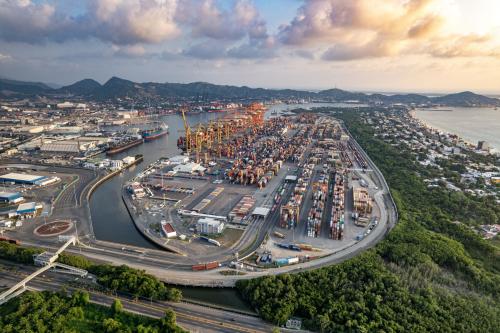
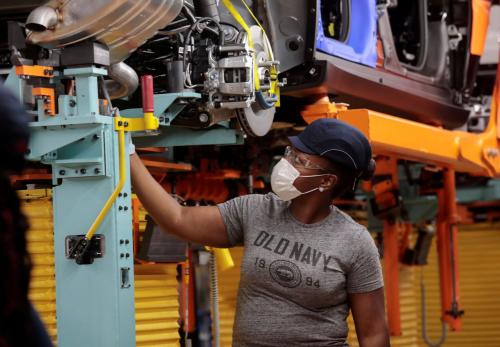

-
Acknowledgements and disclosures
C.J. Mahoney served as deputy United States trade representative during the first Trump administration. He was one of the principal negotiators of the USMCA.
Microsoft is a donor to the Brookings Institution. The conclusions and recommendations of any Brookings publication are solely those of its author(s), and do not reflect the views of the Institution, its management, or its scholars.
-
Footnotes
- Canada and the United States last imposed double digit duties on wide swaths of goods crossing their shared border in the 1930s. https://www.nytimes.com/2025/01/18/world/canada/us-canada-trade-war-1930s.html
- The administration may also pursue additional levies under Section 232 of the Trade Expansion Act of 1962, the law President Trump invoked to impose tariffs on steel and aluminum imports in 2018.
- In Goldwater v. Carter, 444 U.S. 996 (1979), the Supreme Court vacated a lower court decision holding that President Carter lacked authority to terminate a mutual defense treaty with Taiwan without reaching the merits of the controversy; and even if the President has authority to withdraw unilaterally from treaties, it is unclear whether the same principle would apply to congressional-executive agreements like USMCA.
- USITC, USMCA Automotive Rules of Origin: Economic Impact and Operation, 2023 Report, June 2023, 56-57.
- USITC, USMCA Automotive Rules of Origin: Economic Impact and Operation, 2023 Report, June 2023, 56-57.
- Of course, we also wanted to stimulate more investment in the United States. The primary tool for achieving that objective was the separate labor value requirement—a requirement that a certain percentage of cars be manufactured by workers who make at least $16 per hour.
The Brookings Institution is committed to quality, independence, and impact.
We are supported by a diverse array of funders. In line with our values and policies, each Brookings publication represents the sole views of its author(s).


